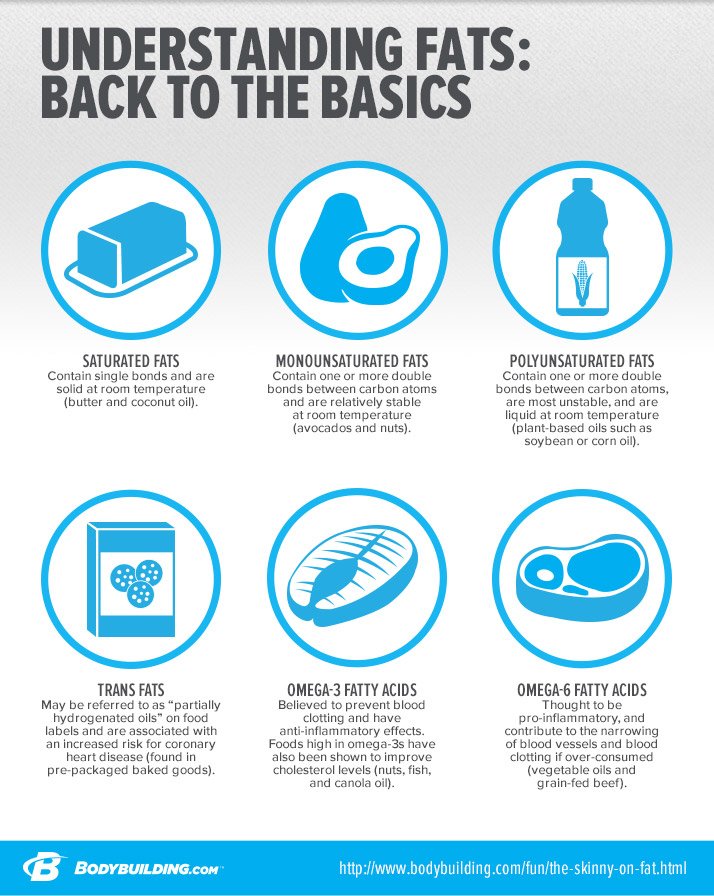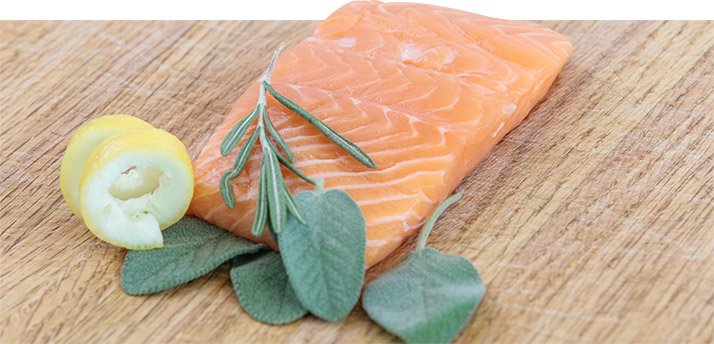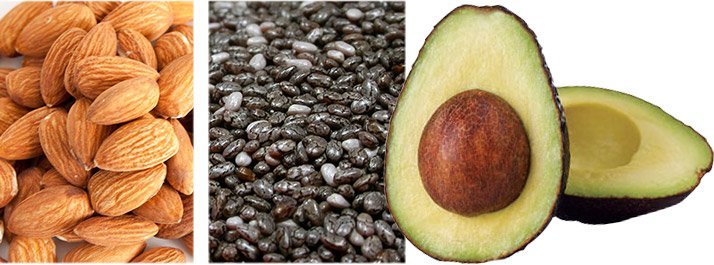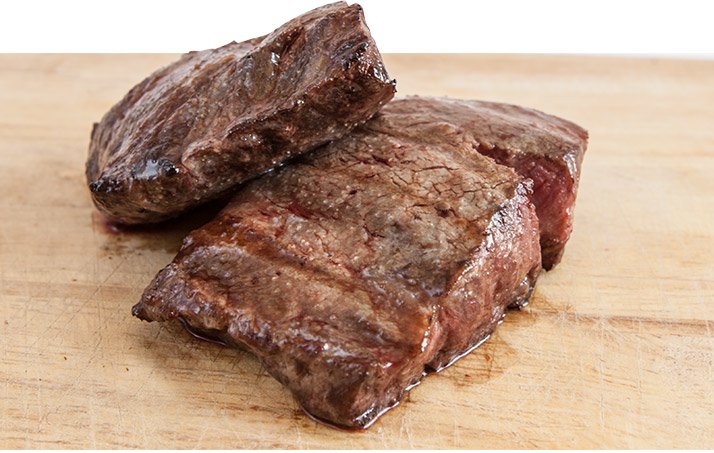
Everything You Know About Fat Is Wrong
For years now, fat has gotten a bad rap. This misunderstood macronutrient can actually provide a wealth of health benefits. It's time to show fat some love!
Thankfully, the war on dietary fat is almost over, but it hasn't been an easy fight. We can look as far back as 1977, when the U.S. government first told us to follow low-fat diets and minimize saturated fats to reduce the risk of cardiovascular disease, cancer, high blood pressure, and everything in between. What followed was a monumental shift in the food industry toward promoting low-fat foods, slapping low-fat claims on any and every food in sight. Low-fat water? I'll take that!
Interestingly enough, this did nothing to slow down the rates of heart disease, obesity, and type 2 diabetes in our country. In fact, these top the list of chronic diseases in the U.S. So maybe fat isn't the enemy.
After battling decades of fat-bashing, it seems as if the U.S. government, health professionals, and athletes are finally coming to our senses and appreciating fat as an important macronutrient with a myriad of functions and health benefits. With a growing interest in higher-fat diets, it's time to set the record straight when it comes to fat and your health.
Understanding Fats: Back to the Basics
Let's be clear: We need fat in our diet, but not all fat is created equal. Understanding the different types of fat—and knowing which ones are most beneficial—is just as important as including them in your diet.

Saturated vs. Unsaturated vs. Trans Fat
Simply put, fatty acids are carbon atoms linked together like a chain, with either a single or double bond between each carbon.
Saturated fats contain single bonds and are solid at room temperature (think butter or coconut oil). Conversely, unsaturated fats contain one or more double bonds between carbon atoms. Monounsaturated fats (avocados, nuts) are relatively stable at room temperature, whereas polyunsaturated (plant-based oils such as soybean or corn oil) are most unstable and are liquid at room temperature.
Many so-called experts associated saturated fats with the buildup of plaque in arteries and cardiovascular disease, although more recently this association has been called into question. A study published in The American Journal of Clinical Nutrition presented results from a symposium of nutrition researchers, concluding that insufficient evidence exists to suggest that replacing saturated fat with unsaturated fats reduces the risk of cardiovascular disease.1
This was echoed in 2011, when researchers out of the Netherlands concluded that the focus should be to avoid the accumulation of saturated fat in the body (accumulation of saturated fat the body can also occur from the synthesis of fatty acids from carbohydrates), rather than avoiding dietary saturated fat per se.2 So it appears that while saturated fats may play a role in inflammation, in isolation they may not be as harmful as once thought.
Trans Fat
Naturally, fatty acids are almost exclusively found in the cis formation (a double bond in the carbon chain, giving the molecule a bent shape). Commercial hydrogenation adds hydrogen ions to fatty acids, causing a straightening of the bond. This process has primarily been used to prolong the shelf life of products and reduce refrigeration requirements.
Trans fats, which are commonly found in pre-packaged baked goods—and which may be referred to as "partially hydrogenated oils" on food labels—are associated with an increased risk for coronary heart disease.3,4 Although trans fat are more regulated now than they were 10 years ago, they are still prevalent in processed foods.
Omega-3 vs Omega-6
What makes an omega-6 different from an omega-3? Nothing more than the placement of a double carbon bond in relation to a methyl group. Pretty nerdy words, but the placement of the double bond has a big impact on its function in the body.

In fact, the difference almost makes the two types polar opposites, in that omega-3 fatty acids are believed to prevent blood clotting and have anti-inflammatory effects. Omega-6 fatty acids, on the other hand, are thought to be pro-inflammatory, and contribute to the narrowing of blood vessels and blood clotting.
In this light, the omega-6:omega-3 ratio appears to a big player in inflammation, and general health. Depending on who you ask, the standard American diet has a ratio of anywhere from 12:1 to 20:1. A ratio closer to 5:1 or lower may be more beneficial for cardiovascular health.5
Foods high in omega-3s (nuts, fish, and canola oil) have also been shown to improve cholesterol levels.
Ideally, total cholesterol levels—the combination of high-density lipoproteins (HDL), low-density lipoproteins (LDL), and triglycerides—should be lower than 200 milligrams per deciliter (mg/dL).
HDL, often termed the "good" cholesterol, scoops cholesterol from the blood and arteries, delivering it to the liver to be excreted. Although the cardioprotective effects of HDL are a bit unclear, high levels of HDL are generally associated with a reduced cardiovascular risk and potentially act as an anti-inflammatory.6,7 Until medical science provides a solid answer on HDL—which may take a while—aim to keep HDL levels above 60 mg/dL.
LDL, often termed "bad cholesterol", transports cholesterol to cells in the body to be used for a variety of functions. Unfortunately, this can also lead to a buildup of cholesterol in arterial walls, increasing the risk of atherosclerosis and cardiovascular disease. Ideally, LDL levels should measure below 100 mg/dL.
The Benefits of Healthy Fats
I don't care what IIFYMers say: Having a fried Oreo hardly provides the same amount of quality fats as a grilled salmon fillet. Obviously, the Oreo is delicious, but if your goal is to get more beach-ready rather than develop metabolic syndrome, drop the greasy stuff and stick to high quality oils, nuts, seeds, and avocados.

So despite being vilified by mainstream media, fat has stood the test of time and is finally starting to be respected as an important player in our health. Here's a rundown of some of the beneficial functions of fat.
Unlimited Amounts of Energy
Fats are energy rich, containing 9 calories per gram—more than twice the amount in carbohydrates and protein. Stored throughout the body, as well as the liver and muscles, fat serves as a large energy reserve that can be tapped into at rest or during low-intensity exercise.
How much energy, you might ask? The average 150-pound male with body fat between 12-15 percent will have 80,000-100,000 calories stored as fat. Compare that to only about 2,000 calories stored as glycogen from carbs. All of this stored fat creates an abundant energy reserve that can supply 60-80 percent of energy at rest.
Armor for Your Body
Ever seen "Flubber?" Notice how Robin Williams can jump out of a 10-story building onto his feet and flubber allows him to bounce back unharmed?

This is essentially what visceral fat does for your organs. While it's unfortunately not neon green like flubber, it's gel-like consistency cushions our internal organs, particularly during falls or during contact sports.
It should be noted that, just like too much flubber was bad for Robin Williams, too much visceral fat may be bad for us. Increased visceral fat has been linked to insulin resistance and an increased risk of cardiovascular disease.8,9
Subcutaneous fat—the stuff located underneath the skin, which gets pinched during a skinfold test—acts an insulator, preventing heat from escaping the body.
Additionally, it helps maintain thermoregulation (the ability to regulate and maintain core body temperature) and subsequent organ and cellular function.
Finally, fat is also used in the formation of myelin, a substance surrounding nerve cells that improves the speed and efficiency of nerve conduction.10
The importance of this substance is most evident in the types of diseases that develop when it is destroyed or damaged, such as multiple sclerosis.
Transportation of Nutrients
Vitamins A, D, E, and K are fat-soluble vitamins. Without adequate fat, these vitamins couldn't be absorbed, transported, or used, and deficiencies would ensue.
Taste and Satiation
Why does a rib-eye taste so much better than the strip sirloin? Probably due to the fat content! Fat offers a distinct texture and flavor to enhance the taste of food. And if you're cutting calories, don't drop all of your fat.

Fat is a calorie-dense molecule, with 9 calories per gram, so it takes a little longer to digest, providing satiation for a longer period of time.
Healthy Fats The Bottom Line
So there you have it: the skinny on fat. Here are my recommendations for fat intake, and where you can find your best sources for quality fat.
- The American Heart Association suggest anywhere between 25-35 percent of your total daily calories come from fat. This will vary depending on your goals.
- Try to keep saturated fats around 10 percent and eliminate trans fat from your diet as best you can.
- Quality sources of fat come from fish, nuts, vegetable and coconut oils, avocados, flax seeds, and cheeses.
- Recommended intake for omega-3s is roughly 1.5-1.8 grams per day to help reduce your risk of heart disease. If you're having trouble meeting this through your diet, you may want to consider supplementation with around 0.5-1.8 grams per day of an omega-3 supplement containing EPA and DHA.11
References
- Astrup, A., Dyerberg, J., Elwood, P., Hermansen, K., Hu, F. B., Jakobsen, M. U., ... & Willett, W. C. (2011). The role of reducing intakes of saturated fat in the prevention of cardiovascular disease: where does the evidence stand in 2010? The American Journal of Clinical Nutrition, 93(4), 684-688.
- Kuipers, R. S., De Graaf, D. J., Luxwolda, M. F., Muskiet, M. H., Dijck-Brouwer, D. A., & Muskiet, F. A. (2011). Saturated fat, carbohydrates and cardiovascular disease. The Netherlands Journal of Medicine, 69(9), 372-378.
- Karbowska, J., & Kochan, Z. (2011). Trans-fatty acids—effects on coronary heart disease. Polski Merkuriusz Lekarski: Organ Polskiego Towarzystwa Lekarskiego, 31(181), 56-59.
- Nestel, P. (2014). Trans fatty acids: are its cardiovascular risks fully appreciated? Clinical Therapeutics, 36(3), 315-321.
- Gómez Candela C, Bermejo López LM, Loria Kohen V (2011). Importance of a balanced omega 6/omega 3 ratio for the maintenance of health: nutritional recommendations. Nutrición Hospitalaria, 26(2):323-329.
- Eren, E., Yilmaz, N., Aydin, O., & Ellidag, H. Y. (2014). Anticipatory Role of High Density Lipoprotein and Endothelial Dysfunction: An Overview. The Open Biochemistry Journal, 31(8), 100.
- Madahian, S., Daniel Navab, K., Pourtabatabaei, N., Seyedali, S., Safar, S., Vazirian, S., & Hough, G. (2014). Inflammation, High Density Lipoprotein and Endothelium. Current Medicinal Chemistry, 21(25), 2902-2909.
- Nakamura, T., Tokunaga, K., Shimomura, I., Nishida, M., Yoshida, S., Kotani, K., ... & Matsuzawa, Y. (1994). Contribution of visceral fat accumulation to the development of coronary artery disease in non-obese men. Atherosclerosis, 107(2), 239-246.
- Sironi, A. M., Petz, R., De Marchi, D., Buzzigoli, E., Ciociaro, D., Positano, V., ... & Gastaldelli, A. (2012). Impact of increased visceral and cardiac fat on cardiometabolic risk and disease. Diabetic Medicine, 29(5), 622-627.
- Schmitt, S., Castelvetri, L. C., & Simons, M. (2015). Metabolism and functions of lipids in myelin. Biochimica et Biophysica Acta (BBA)-Molecular and Cell Biology of Lipids, 1851(8), 999-1005.
- Kris-Etherton, P. M., Harris, W. S., & Appel, L. J. (2003). Fish consumption, fish oil, omega-3 fatty acids, and cardiovascular disease. Arteriosclerosis, Thrombosis, and Vascular Biology, 23(2), e20-e30.
